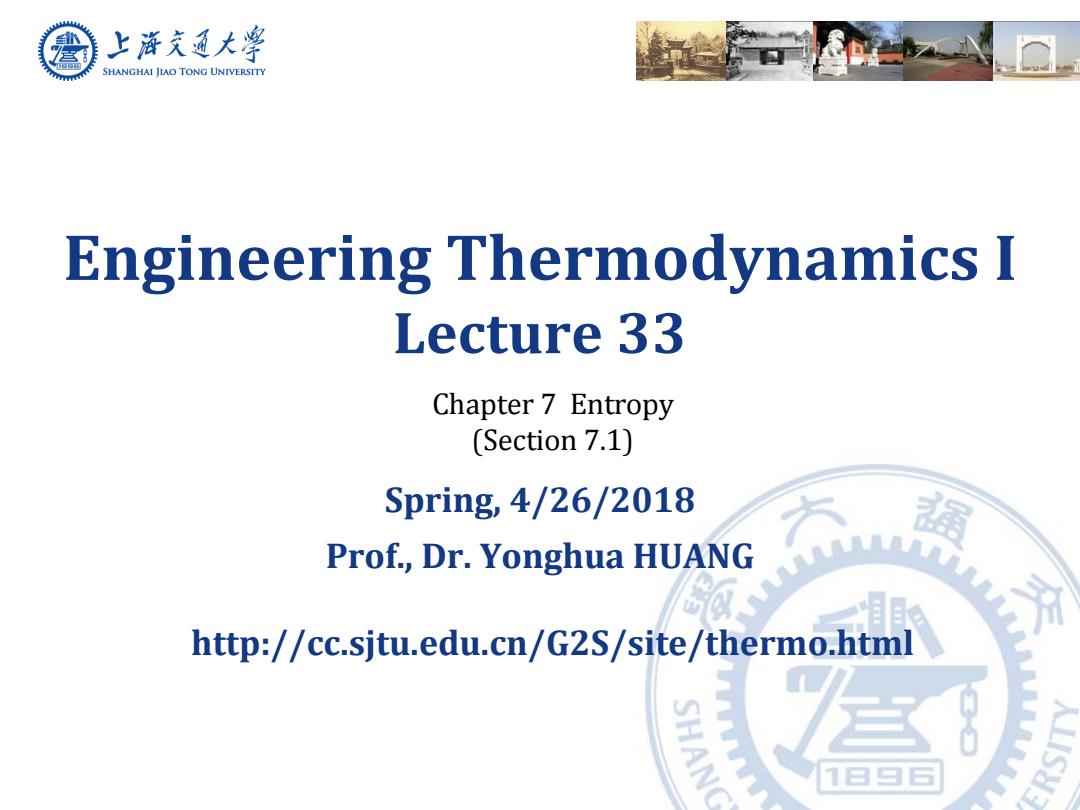
上游充通大学 SHANGHAI JIAO TONG UNIVERSITY Engineering Thermodynamics I Lecture 33 Chapter 7 Entropy (Section 7.1) Spring,4/26/2018 强 Prof.,Dr.Yonghua HUANG MMAMMA http://cc.sjtu.edu.cn/G2S/site/thermo.html 1日G
Engineering Thermodynamics I Lecture 33 Spring, 4/26/2018 Prof., Dr. Yonghua HUANG Chapter 7 Entropy (Section 7.1) http://cc.sjtu.edu.cn/G2S/site/thermo.html

Directionality of processes Who determines the direction? Energy balance (1st law)? Entropy balance (2nd law)? HOT ·Together?? COFFEE Heat Spontaneous? 圈上游通大学 April 26,2018 2 SHANGHAI JLAO TONG UNIVERSITY
April 26, 2018 2 Directionality of processes Spontaneous? • Energy balance (1st law) ? • Entropy balance (2nd law)? • Together? Who determines the direction?
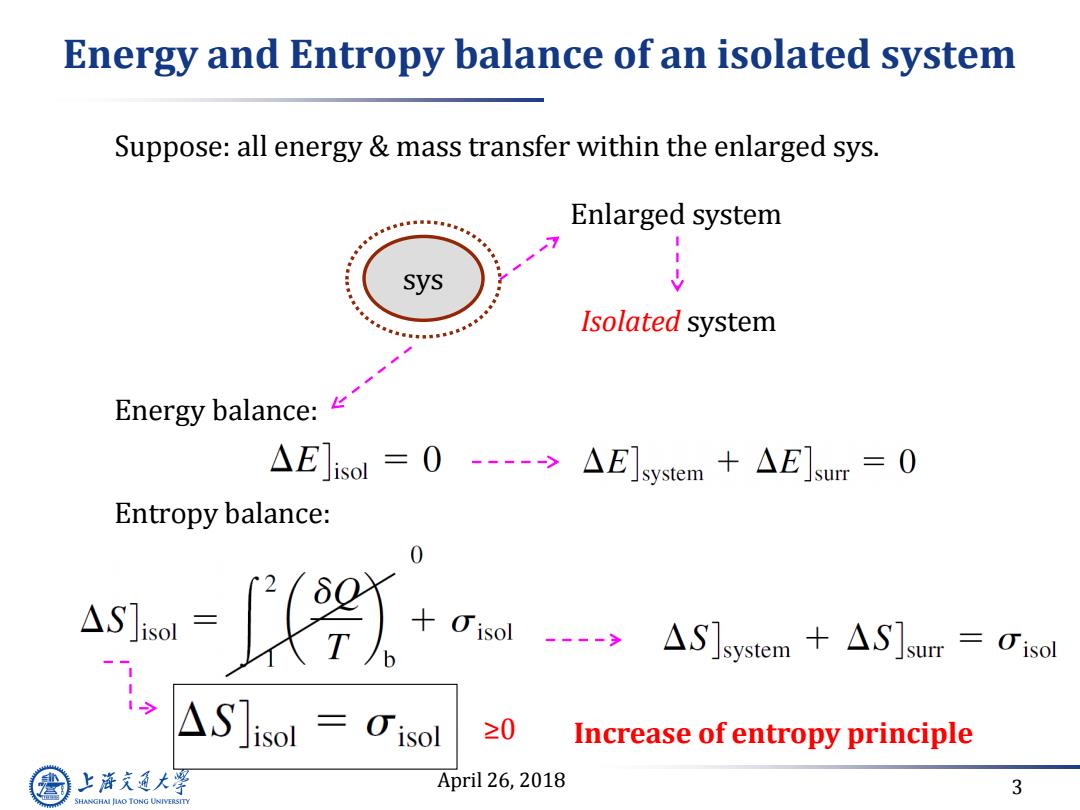
Energy and Entropy balance of an isolated system Suppose:all energy mass transfer within the enlarged sys. Enlarged system -7 sys Isolated system Energy balance: AE]isol=0-->△E]system+△E]sur=0 Entropy balance: agw= △S]isol=0isol ≥0 Increase of entropy principle 上游究通大浮 April 26,2018 3 SHANGHAI JIAO TONG UNIVERSITY
April 26, 2018 3 Energy and Entropy balance of an isolated system sys Enlarged system Isolated system Suppose: all energy & mass transfer within the enlarged sys. Energy balance: Entropy balance: ≥0 Increase of entropy principle
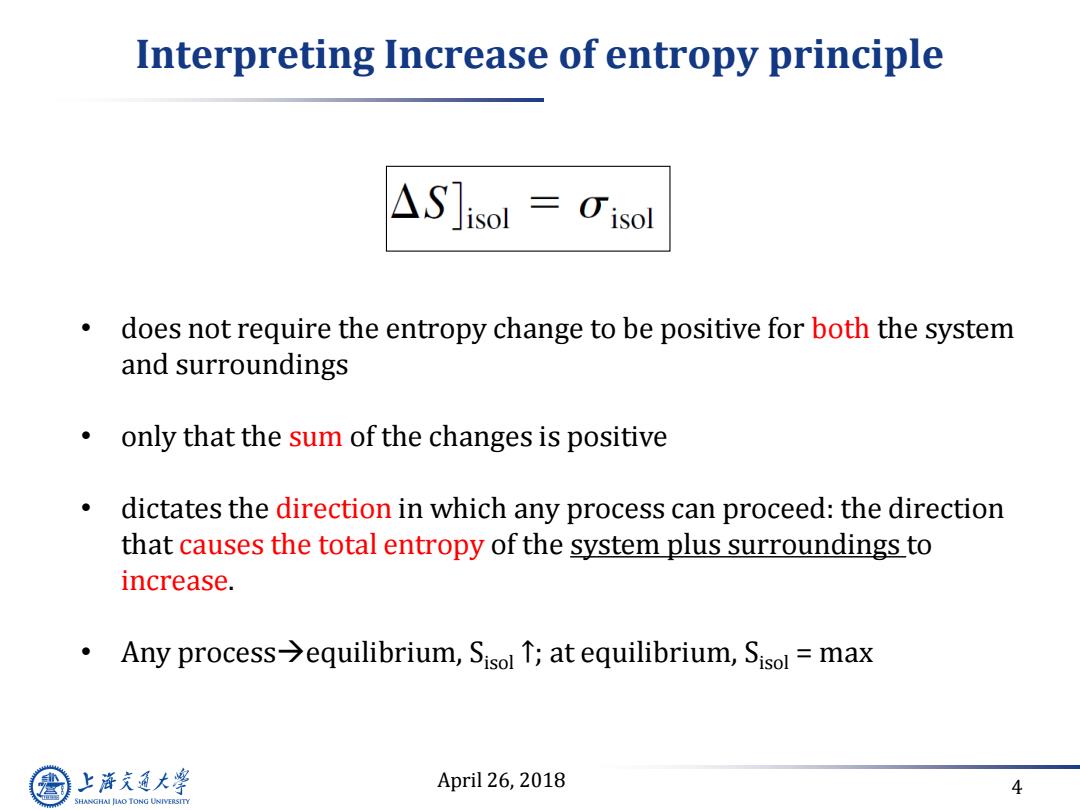
Interpreting Increase of entropy principle △S]isol=0isl does not require the entropy change to be positive for both the system and surroundings only that the sum of the changes is positive dictates the direction in which any process can proceed:the direction that causes the total entropy of the system plus surroundings to increase. Any process>equilibrium,Sisol T;at equilibrium,Sisol =max 上游通大学 April 26,2018 4 SHANGHAI JIAO TONG UNIVERSITY
April 26, 2018 4 Interpreting Increase of entropy principle • does not require the entropy change to be positive for both the system and surroundings • only that the sum of the changes is positive • dictates the direction in which any process can proceed: the direction that causes the total entropy of the system plus surroundings to increase. • Any processequilibrium, Sisol ↑; at equilibrium, Sisol = max
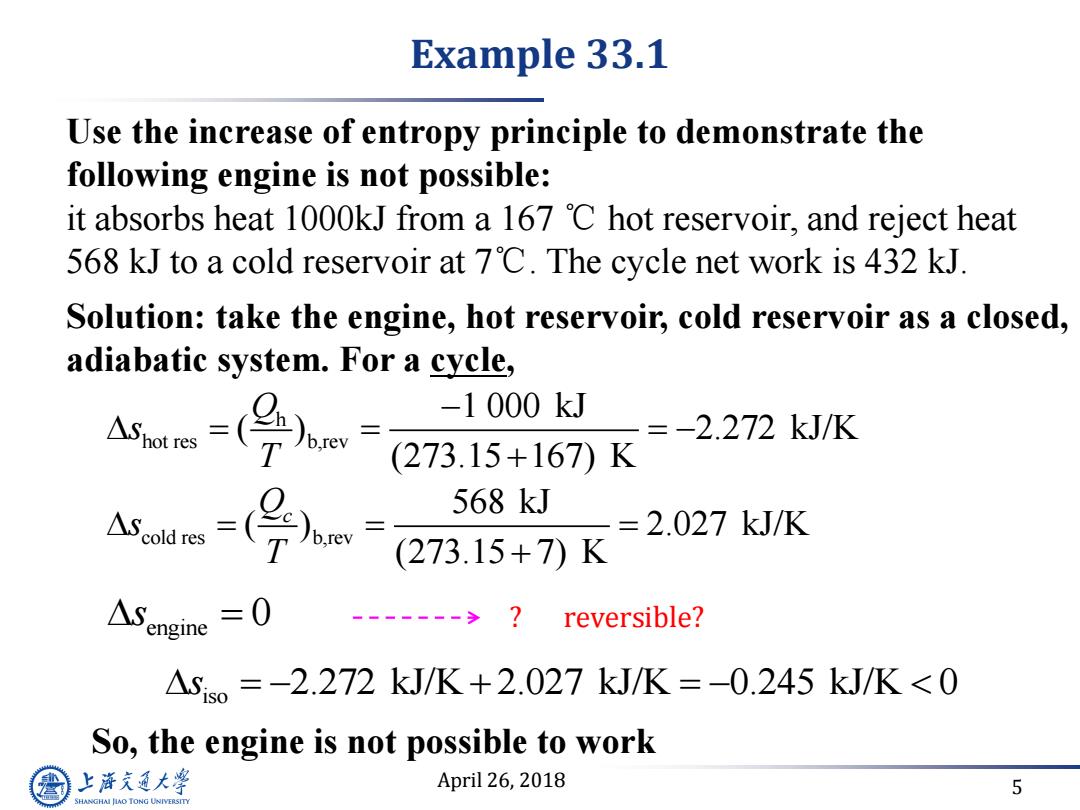
Example 33.1 Use the increase of entropy principle to demonstrate the following engine is not possible: it absorbs heat 1000kJ from a 167 C hot reservoir,and reject heat 568 kJ to a cold reservoir at 7'C.The cycle net work is 432 kJ. Solution:take the engine,hot reservoir,cold reservoir as a closed, adiabatic system.For a cycle, -1000kJ =-2.272kJ/K (273.15+167)K 568kJ =2.027kJ/K (273.15+7)K ASengine =0 reversible? △sso=-2.272kJ/K+2.027kJ/K=-0.245kJ/K<0 So,the engine is not possible to work 上游究通大学 April 26,2018 5 SHANGHAI JLAO TONG UNIVERSITY
April 26, 2018 5 Use the increase of entropy principle to demonstrate the following engine is not possible: it absorbs heat 1000kJ from a 167 ℃ hot reservoir, and reject heat 568 kJ to a cold reservoir at 7℃. The cycle net work is 432 kJ. hot res h b,rev 1 000 kJ ( ) 2.272 kJ/K (273.15 167) K Q s T So, the engine is not possible to work cold res b,rev 568 kJ ( ) 2.027 kJ/K (273.15 7) K Qc s T engine s 0 iso s 2.272 kJ/K 2.027 kJ/K 0.245 kJ/K 0 Solution: take the engine, hot reservoir, cold reservoir as a closed, adiabatic system. For a cycle, Example 33.1 ? reversible?
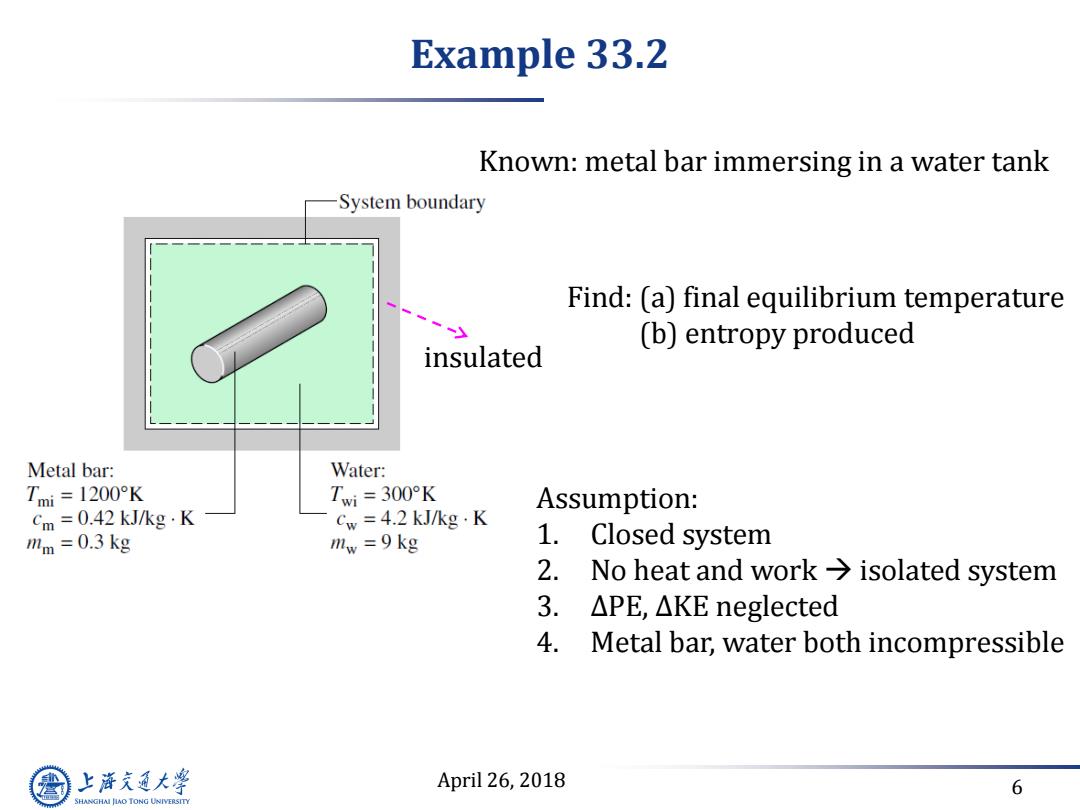
Example 33.2 Known:metal bar immersing in a water tank System boundary Find:(a)final equilibrium temperature (b)entropy produced insulated Metal bar: Water: Tmi=1200°K Twi=300K Cm=0.42kJ/kg·K Cw=4.2kJ/kg·K Assumption: mm =0.3 kg mw =9 kg 1. Closed system 2. No heat and work>isolated system 3. △PE,△KE neglected 4. Metal bar,water both incompressible 上游充通大学 April 26,2018 6 SHANGHAI JLAO TONG UNIVERSITY
April 26, 2018 6 Example 33.2 Known: metal bar immersing in a water tank insulated Find: (a) final equilibrium temperature (b) entropy produced Assumption: 1. Closed system 2. No heat and work isolated system 3. ∆PE, ∆KE neglected 4. Metal bar, water both incompressible
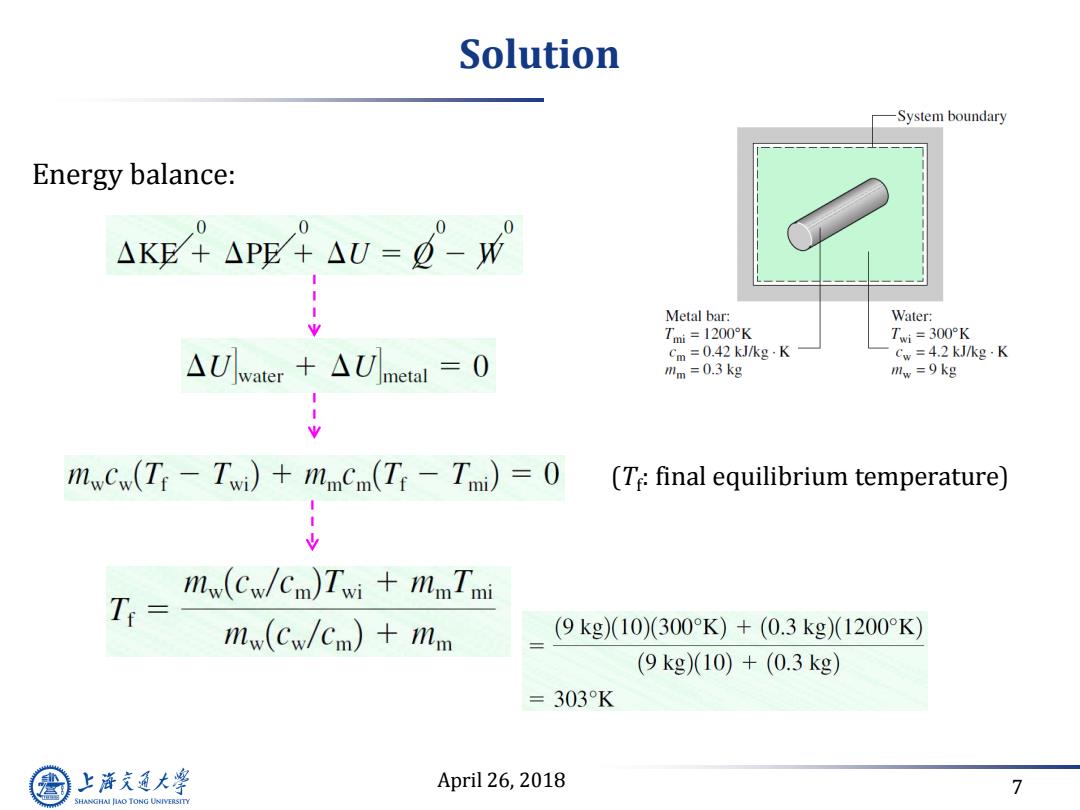
Solution System boundary Energy balance: AKE APE AU-6-W Metal bar: Water: Tmi =1200K Twi =300K △water+△metal=0 Cm =0.42 kJ/kg-K Cw =4.2 kJ/kg.K mm =0.3 kg mw=9 kg mwCw(Tr-Twi)+mmCm(Tr-Tmi)=O (T:final equilibrium temperature) mw(Cw/Cm)Twi mmTmi T= mw(Cw/cm)+mm (9kg)10)(300K)+(0.3kg)(1200°K) (9kg10)+(0.3kg) =303K 上游充通大 April 26,2018 7 SHANGHAI JLAO TONG UNIVERSITY
April 26, 2018 7 Solution Energy balance: (Tf : final equilibrium temperature)
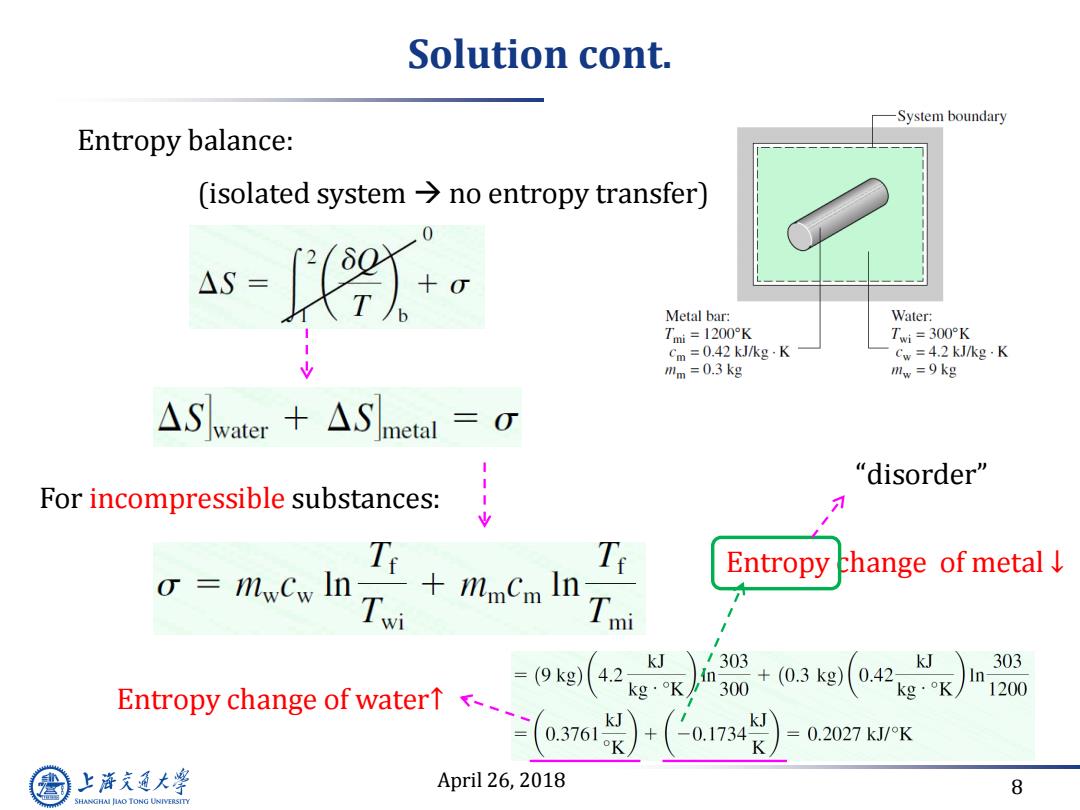
Solution cont. System boundary Entropy balance: (isolated system>no entropy transfer) s=) Metal bar: Water: Tmi =1200K Twi=300K cm=0.42kJkg·K Cw =4.2 kJ/kg.K mm =0.3 kg mw=9 kg △Swater+△Smetal "disorder" For incompressible substances: mc nsi Tr +mmCm In Entropy change of metal =(9kg) kJ +ao(ae) )303 k 303 42 Entropy change of waterT- g·K 1200 -01734 0.2027kJ/K 上游充通大 April 26,2018 8 SHANGHAI JLAO TONG UNIVERSITY
April 26, 2018 8 Solution cont. Entropy balance: (isolated system no entropy transfer) For incompressible substances: Entropy change of water↑ Entropy change of metal ↓ “disorder

Example 33.3 Chemical problem Chemical reaction:1 mol CO and 0.5 mol O2 atp=1 atm,=25 C,final product 1 mol CO2.measured rejected heat 283 190 J,no work output. Assuming the molar basis entropy of CO,O2,and CO2 are 197.67 J/(mol-K), 205.167 J/(mol-K),and 213.82 J/(mol-K)at (p.t),respectively. Question:are these data correct/reliable?(surrounding to=25 C) Solution Take CO,O2,COz and the surrounding as system C0+02=C02 A心-Su-Sw+oA, Isolated system =1mol×213.82J/(mol.K)-[1mol×197.67J/(mol·K) 283190J +0.5mol×205.16J/(mol·K)]+ =863.4J/K>0 (273+25)K So,not violate the 2nd law.Increase of entropy principle also applies to chemical reaction. 上商充通大学 April 26,2018 9 SHANGHAI JLAO TONG UNIVERSITY
April 26, 2018 9 Chemical reaction: 1 mol CO and 0.5 mol O2 at p = 1 atm, t= 25 ℃, final product 1 mol CO2 . measured rejected heat 283 190 J, no work output. Assuming the molar basis entropy of CO, O2 , and CO2 are 197.67 J/(mol·K), 205.167 J/(mol·K) , and 213.82 J/(mol·K) at (p, t), respectively. Question: are these data correct/reliable?(surrounding t0= 25 ℃) Solution: 2 2 1 CO+ O =CO 2 Take CO, O2 , CO2 and the surrounding as system 2 2 iso CO CO O 0 1 2 S S S S S 1 mol 213.82 J/(mol K) [1 mol 197.67 J/(mol K) 283 190 J 0.5 mol 205.16 J/(mol K)] 863.4 J/K 0 (273 25) K So, not violate the 2nd law. Increase of entropy principle also applies to chemical reaction. Example 33.3 Chemical problem Isolated system
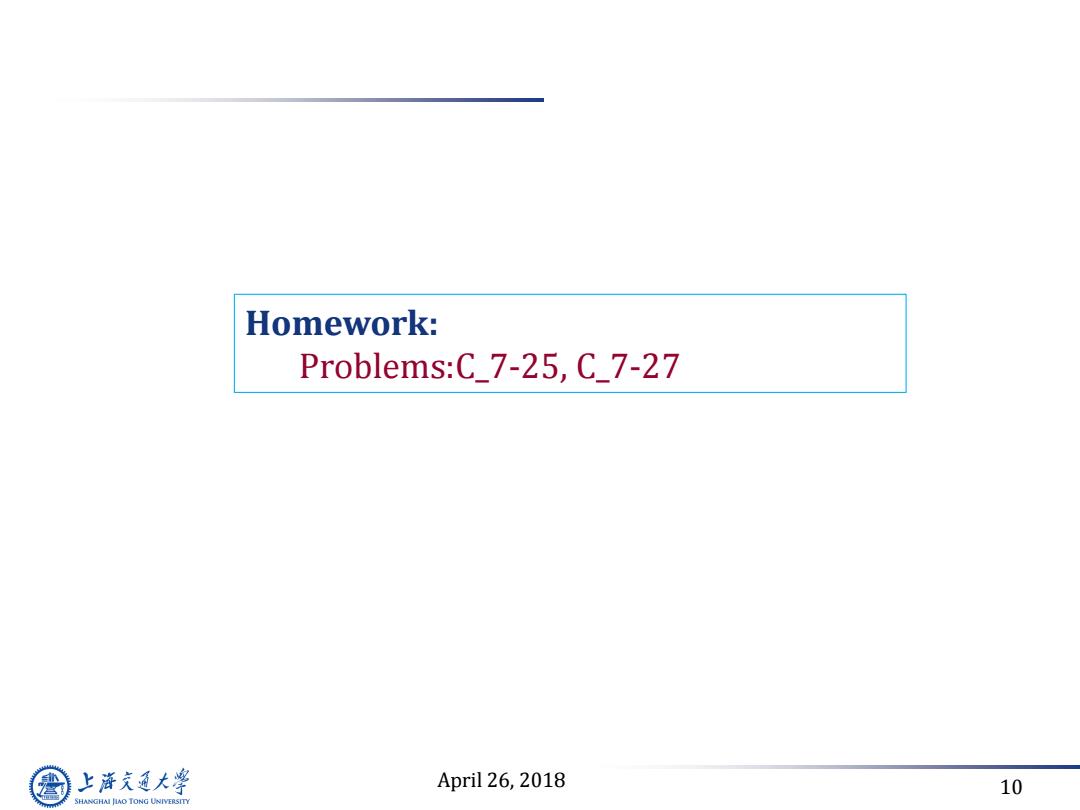
Homework: Problems:C_7-25,C_7-27 上游充通大学 April 26,2018 10 SHANGHAI JLAO TONG UNIVERSITY
April 26, 2018 10 Homework: Problems:C_7-25, C_7-27